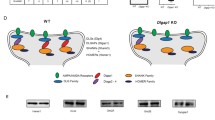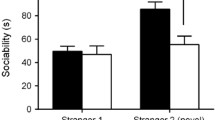Gamma (γ) synuclein is a member of the family of synucleins, which are cytoplasmic, predominantly, neuronal, proteins found only in vertebrates. Significant quantities of γ-synuclein are found in the axons and presynaptic terminals of neurons located in brain areas responsible for forming emotions and memory. However, the involvement of γ-synucleins in controlling neuronal and synaptic processes underlying various types of behavior in humans and animals have not yet been studied. We provide the first demonstration that the absence of γ-synuclein increases orientational-investigative activity in a novel context and decreases the level of situational anxiety in animals.
Similar content being viewed by others
References
V. L. Bukhman, “Synucleins – keys to the mechanisms of neurodegenerative disorders?” Molecule. Biol., 32, 592–597 (1998).
N. N. Ninkina and V. L. Bukhman, “Synucleins – to have or not to have?” Genetika, 36, 1487–1492 (2000).
A. Abeliovich, Y. Schmitz, I. Farinas, D. Choi-Lundberg, W. H. Ho, P. E. Castillo, N. Shinsky, J. M. Verdugo, M. Armanini, A. Ryan, M. Hynes, H. Phillips, D. Sulzer, and A. Rosenthal, “Mice lacking alpha-synuclein display functional deficits in the nigrostriatal dopamine system,” Neuron, 25, 239–252 (2000).
A. Al-Wandi, N. N. Ninkina, S. Millership, S. J. Williamson, P. A. Jones, and V. L. Buchman, “Absence of alpha-synuclein affects dopamine metabolism and synaptic markers in the striatum of aging mice,” Neurobiol. Aging, 31, 796–804 (2010).
M. Angrini, J. C. Leslie, and R. A. Shephard, “Effects of propranolol, buspirone, pCPA, reserpine, and chlordiazepoxide on openfield behavior,” Pharmacol. Biochem. Behav., 59, 387–397 (1998).
C. Belzung and G. Griebel, “Measuring normal and pathological anxiety-like behaviour in mice: a review,” Behav. Brain Res., 125, 141–149 (2001).
V. L. Buchman, H. J. Hunter, L. G. Pinõn, J. Thompson, E. M. Privalova, N. N. Ninkina, and A. M. Davies, “Persyn, a member of the synuclein family, has a distinct pattern of expression in the developing nervous system,” J. Neurosci., 18, 9335–9341 (1998).
V. L. Buchman and N. N. Ninkina, “Modulation of alpha-synuclein expression in transgenic animals for modelling synucleinopathies – is the juice worth the squeeze?” Neurotox. Res., 14, 329–341 (2008).
M. Carli, C. Prontera, and R. Samanin, “Effect of 5-HT1A agonists on stress-induced deficit in open field locomotor activity of rats: evidence that this model identifies anxiolytic-like activity,” Neuropharmacology, 28, 471–476 (1989).
S. Chandra, F. Fornai, H. B. Kwon, U. Yazdani, D. Atasoy, Z. Liu, R. E. Hammer, G. Battaglia, D. C. German, P. Castillo, and T. C. Sudhof, “Double-knockout mice for alpha- and beta-synucleins: effect on synaptic functions,” Proc. Natl. Acad. Sci. USA, 101, 14966–14971 (2004).
F. Curulli, L. De Acetis, and E. Alleva, “Behavioral effects of peripheral interleukin-1 administration in adult CD-1 mice: specific inhibition of the offensive components of intermale agonistic behavior,” Brain Res., 791, 308–312 (1998).
W. Dauer, N. Kholodilov, M. Vila, A. C. Trillat, R. Goodchild, K. E. Larsen, R. Staal, K. Tieu, Y. Schmitz, C. A. Yuan, M. Rocha, V. Jackson-Lewis, S. Hersch, D. Sulzer, S. Przedborski, R. Burke, and R. Hen, “Resistance to alpha-synuclein null mice to the parkinsonian neurotoxin MPTP,” Proc. Natl. Acad. Sci. USA, 99, 14524–14529 (2002).
K. K. Dev, KI. Hofele, S. Barbieri, V. L. Buchman, and H. van der Putten, “Part II: alpha-synuclein and its molecular pathophysiological role in neurodegenerative disease,” Neuropharmacology, 45, 14–44 (2003).
D. L. Fortin, M. D. Troyer, K. Nakamura, S. Kabo, M. D. Anthony, and R. H. Edwards, “Lipid rafts mediate the synaptic localization of alpha-synuclein,” J. Neurosci., 24, 6715–6723 (2004).
K. Howard, D. Gershenfeld, P. E. Neumann, C. Mathis, J. N. Crawley, L. I. Xiaohua, and S. M. Paul, “Mapping quantitative trait loci for open-field behavior in mice,” Behav. Genet., 27, 201–210 (1997).
R. G. Lister, “The use of a plus-maze to measure anxiety in the mouse,” Psychopharmacology, 92, 180–185 (1987).
P. Malmberg-Aiello, A. Ipponi, A. Bartolini, and W. Schunack, “Mouse light/dark box test reveals anxiogenic-like effects by activation of histamine H1 receptors,” Pharmacol. Biochem. Behav., 71, 313–318 (2002).
J. M. Marques, I. A. Olsson, S. O. Ogren, and K. Dahlborn, “Evaluation of exploration and risk assessment in pre-weaning mice using the novel cage test,” Physiol. Behav., 93, 139–147 (2008).
A. G. Nasello, C. Machado, J. F. Bastos, and L. F. Felicio, “Sudden darkness induces a high activity-low anxiety state in male and female rats,” Physiol. Behav., 63, 451–454 (1998).
N. N. Ninkina, M. V. Alimova-Kost, J. W. Paterson, L. Delaney, B. B. Cohen, S. Imreh, N. V. Gnuchev,A. M. Davies, and V. L. Buchman, “Organization, expression and polymorphism of the human persyn gene,” Hum. Mol. Genet., 7, 1417–1424 (1998).
N. N. Ninkina, K. Papachroni, D. C. Robertson, O. Schmidt, L. Delany, F. O’Neill, F. Court, A. Rosenthal, S. M. Fleetwood-Walker, A. M. Davies, and V. L. Buchman, “Neurons expressing the highest levels of gamma-synuclein are unaffected by targeted inactivation of the gene,” Mol. Cell. Biol., 23, 8233–8245 (2003).
N. N. Ninkina, O. Peters, S. Millership, H. Salem, H can der Putten, and V. L. Buchman, “Gamma-synucleinopathy: neurodegeneration associated with overexpression of the mouse protein,” Hum. Mol. Genet., 18, 1779–1794 (2009).
S. Ramboz, R. Oosting, D. A. Amara, H. F. Kung, P. Blier, M. Mendelsohn, J. J. Mann, D. Brunner, and R. Hen, “Serotonin receptor 1A knockout: an animal model of anxiety-related disorder,” Proc. Natl. Acad. Sci. USA, 95, 14476–14481 (1998).
D. C. Robertson, O. Schmidt, N. N. Ninkina, P. A. Jones, J. Sharkey, and V. L. Buchman, “Developmental loss and resistance to MPTP toxicity of dopaminergic neurones in substantia nigra pars compacta of gamma-synuclein, alpha-synuclein and double alpha/gammasynuclein null mutant mice,” J. Neurochem., 89, 1126–1136 (2004).
S. L. Senior, N. N. Ninkina, R. Deacon, D. Bannerman, V. L. Buchman, S. J. Cragg, and R. Wade-Martins, “Increased striatal dopamine release and hyperdopaminergic-like behaviour in mice lacking both alpha-synuclein and gamma-synuclein,” Eur. J. Neurosci., 27, 947–957 (2008).
J. K. Shepherd, S. S. Grewal, A. Fletcher, D. J. Bill, and C. T. Dourish, “Behavioural and pharmacological characterisation of the elevated ‘zero-maze’ as an animal model of anxiety,” Neurosci., 149, 477–486 (2007).
M. G. Spillantini and M. Goedert, “The alpha-synucleinopathies: Parkinson’s disease, dementia with Lewy bodies, and multiple system atrophy,” Ann. N.Y. Acad. Sci., 920, 16–27 (2000).
T. Strekalova, R. Spanagel, O. Dolgov, and D. Bartsch, “Stressinduced hyperlocomotion as a confounding factor in anxiety and depression models in mice,” Behav. Pharmacol., 16, 171–180 (2005).
S. Totterdell and G. E. Meredith, “Localization of alpha-synuclein to identified fibers and synapses in the normal mouse brain,” Neurosci., 135, 907–913 (2005).
S. Yu, K. Ueda, and P. Chan, “Alpha-synuclein and dopamine metabolism,” Mol. Neurobiol., 31, 243–254 (2005).
Author information
Authors and Affiliations
Corresponding author
Additional information
Translated from Zhurnal Vysshei Nervnoi Deyatel’nosti imeni I. P. Pavlova, Vol. 61, No. 1, pp. 85–93, January–February, 2011.
Rights and permissions
About this article
Cite this article
Kokhan, V.S., Bolkunov, A.V., Ustiugov, A.A. et al. Targeted Inactivation of the Gene Encoding Gamma-Synuclein Affects Anxiety Levels and Investigative Activity in Mice. Neurosci Behav Physi 42, 575–581 (2012). https://doi.org/10.1007/s11055-012-9603-1
Received:
Accepted:
Published:
Issue Date:
DOI: https://doi.org/10.1007/s11055-012-9603-1




